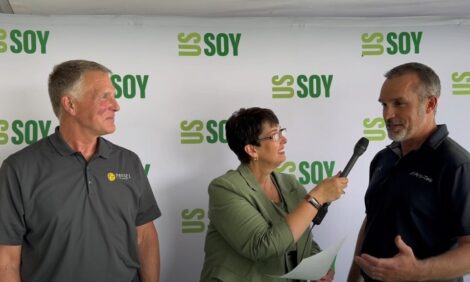



Lost days - the key to breeding herd efficiency
By Bernard Peet, Pig Production Training and thePigSite Consultant - Lost days, empty days or non-productive days (NPDs) are one of the most important influences on breeding herd efficiency. They represent the number of days in the breeding cycle or per year when the sow or gilt is not either pregnant or lactating.
Breeding herd productivity is usually defined in terms of pigs weaned per sow per year. Breaking this down into its basic components shows it to be a function of the number of piglets reared and litters/sow/year:

Data from herd recording systems show that differences in litters/sow/year (LSY) is the biggest reason for differences between farms in terms of pigs/sow/year. Because gestation length and the lactation period are effectively fixed, NPDs are therefore the key to maximizing efficiency. This is not to say that pigs born alive and pre-wean mortality are unimportant, but certainly litter size is much more difficult to influence than NPDs.
NPDs directly affect unit profitability due to their influence on the number of pigs sold. If output is reduced, sales decrease and overhead costs per pig increase. Consider two units, each of 500 sows and mated gilts, one with 45 and the other with 30 NPDs per sow per year. Their respective figures for LSY can be calculated using the formula:
Assuming a gestation length of 115 days and 20 days lactation, this results in 2.37 and 2.48 LSY respectively. If 9.5 pigs are weaned per litter, the difference in output is (2.48 - 2.37) x 9.5 pigs x 500 sows = 522 pigs weaned.
If these pigs are finished, they would incur feed costs of say $67 per pig and a small amount of variable costs, maybe $3/pig because, irrespective of output, all other unit costs remain the same. Therefore the total difference in margin, assuming 5% death loss, a $1.40/kg market price and 110 index, is:
The difference in NPDs between the two herds is 500 sows x 15 days = 7500 days, therefore the cost per lost day is $4.74.
This is the simplest way of working out the cost of reduced output and assumes that the costs of operating the breeding herd are more or less fixed and that nursery and finishing space is available if pigs weaned/sow increases. Another approach, suggested by Dr Morgan Morrow, an American veterinarian, is to estimate the opportunity cost of not having a sow farrowing:
- A sow producing 23 pigs sold/year produces 0.063 pigs/day.
- If the marginal profit on each pig sold is $71.68 (as above) then the cost of each lost day is 0.063 x $71.68 = $4.52 per day, a very similar figure to the one calculated above.
Taking the two examples of 45 and 30 NPD's per sow per year, the difference of 15 days is equivalent to about $71 per sow, $3.23 per pig sold or 3.5 cents per kg sold. Whichever way one looks at it, empty days are expensive and it is not unusual to see herds with 50 - 60 empty days. Minimizing NPDs is therefore the most important aspect of sow management after breeding.
Successful management depends on accurate identification of sows not in pig, a prompt decision on what to do with them and effective action to get them back in pig or sold. Key aspects of identification routines are:
- Carefully observe sows from day 14-15 after service for signs of slight discharge or sticky mucus - mark any sows in which this is seen, they are likely to return.
- Provide intense nose to nose stimulation using a mature boar for heat checking at 18 - 24 days. Ensure enough time is spent on this task because 60%+ of returns occur during this period.
- Continue daily heat checking up to the second pregnancy check (PD).
- Carry out a first PD at 28-35 days and a second at 49-56 days. Re-check all doubtful or -ve sows on the same day, then if still negative, a week later.
- Perform a visual PD at 70 days and check daily up to farrowing. If doubtful, carry out a further PD.
Detecting sows that return or are not in pig does not on its own reduce lost days. In too many cases sows are left hanging around and given the benefit of the doubt, so strict rules must be made regarding treatment of these animals. First returns should obviously be re-bred, however, the farrowing rate of sows served at second and subsequent returns is likely to be very poor. Ideally these sows should be culled immediately, assuming that the weekly breeding target can still be met. Sows found open during pregnancy testing should always be moved to an area with other "problem" sows and given intense daily stimulation with the boar. Often this will trigger a return to estrus; if not an injection of PG600 (Intervet) after 7 days may bring a response. If estrus still does not occur, a second injection should be given 10-12 days after the first. If the sow has not shown estrus after 21 days of stimulation, she should be culled immediately, after a precautionary pregnancy check. PG600 will not cause any problems to pregnant sows if an error was made in the original pregnancy test.
The way the breeding and gestation areas are organized and the pig flow within them can have a big effect on the ability to reduce lost days. It is essential that the status of each sow in the system is known every day so that the appropriate management can be carried out. This requires the sow's record card to be easily accessible and readable. The use of coloured marker pens to record key events such as PD +ve improve identification and save time.
The largest source of lost days, nearly 50% of the total, is the weaning to first service interval. Many producers treat these as unavoidable, but action to minimize W-S interval is extremely cost effective. First, a reduction of even 0.5 days per sow makes a worthwhile contribution to overall lost days because it applies to all sows. Second, and more important, is that W-S interval is closely correlated to subsequent farrowing rate and litter size. Apparently small changes in average W-S interval and a reduction in its variability has a large effect on overall productivity. One of the most important influences on W-S interval is lactation feed intake and close attention to feeding management, water provision and environment can help to reduce it.
In some herds a significant number of NPDs arise from sows that have to be culled or which die during pregnancy. These losses can be minimized by ensuring that the sows' physical environment, especially flooring, is well maintained. Also, prompt identification and treatment of sick, injured or disadvantaged sows and gilts is important in this respect. Finally, ensuring that sow body condition is adequately maintained at all stages in the reproductive cycle will reduce the incidence of health problems.
Lost days or NPDs drive breeding herd productivity in a number of ways, not only through their influence on LSY, but through the effect of wean-service interval on litter size and farrowing rate. Focussing management effort on this vital area will reap large rewards in numbers of pigs weaned per sow per year.
|







